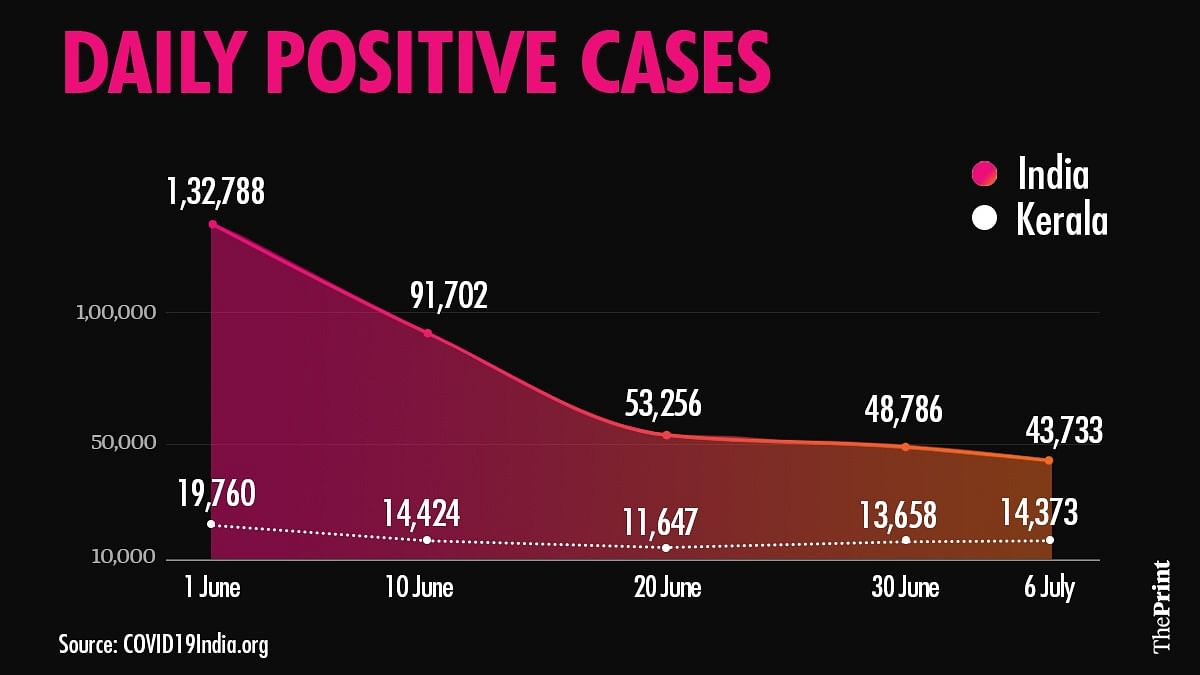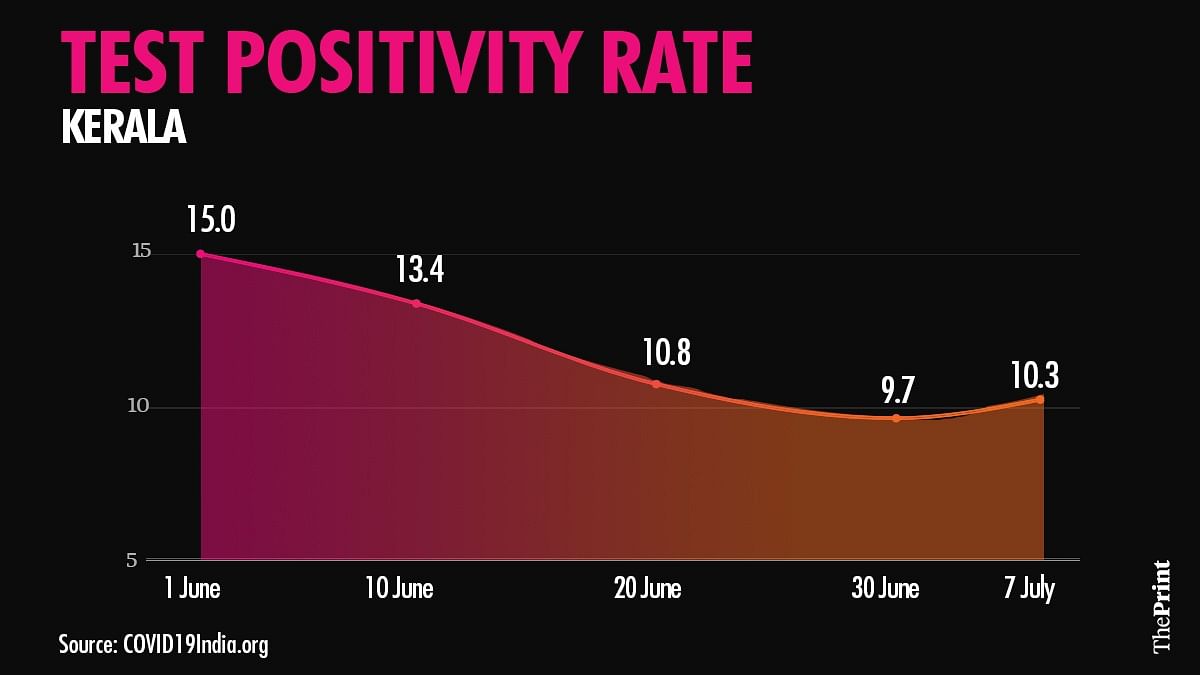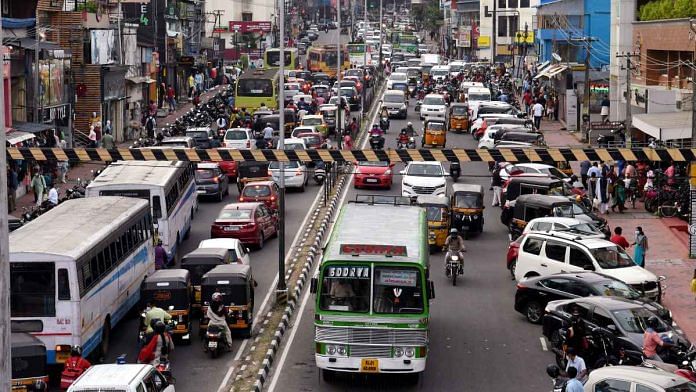New Delhi: With Covid-19 numbers plateauing at a fairly high level, and last week’s test positivity rate (TPR) settling at over 10 per cent, the situation in Kerala has raised concern, with the Centre Tuesday asking the state to ramp up vaccinations and testing, step up infrastructure planning and ensure Covid appropriate behaviour.
A central team travelled to the state last week after Kerala consistently registered high Covid case numbers. In fact, of the 90 districts across the country that account for 80 per cent of the new cases, 14 are in Kerala. Only Tamil Nadu and Maharashtra, with 15 districts each, rank above it; both are way bigger states in terms of size.
On 1 June, the state recorded 19,760 positive cases, but the number began declining, reaching 14,424 on 10 June. Since then, it has been showing daily numbers in the 11,000-15,000 range (weekends excluded). However, the numbers have since been range bound.

This is unusual for an infectious disease as case numbers either plummet or spike, based on how well containment measures work. The plateauing, though, is a phenomenon Kerala found earlier too; at the peak of the second Covid wave, case tallies plateaued in the 4,000-5,000 range.
Health Economist Rijo John, who has been tracking India’s Covid-19 numbers very closely, said, “If you remember, Kerala’s previous peak plateaued at about 4,000-5,000 and refused to come down. Even as we were there, this peak happened and the numbers have now settled at a higher plateau. It is difficult for me to say why that is but I live in Cochin and around me, even during weekends, when it is supposed to be a triple lockdown, I see major violations … there are no cops on the road.”
The triple lockdown refers to restrictions on the movement of people, containment in clusters and focus on households of infected people.
Responding to ThePrint’s queries, Principal Secretary, health, Rajan Khobragade said: “(Even) Those who do good prevention will be susceptible to the infection. In our country, serosurveillance of antibodies tells (us) what is the likely proportion of infection. Please get those numbers. Do a projection of infected persons. Analyse what happened in cities and rural areas. For any disease control, detection is the most important step which is (being) done properly in deep interiors of rural Kerala as well.”
“Identifying positives cannot be interpreted in a negative way. What is important to see is how the cases are managed. Focus cannot be on Covid only … focus should be on what is happening to the whole lot … We are managing that also efficiently. That is the resilience of the Kerala health system,” he added.
Khobragade said the state was continuing prevention and vaccination measures, and added that they are capable of administering more than 3 lakh doses per day. “The vaccine should be provided,” he pointed out.
Currently, over 10 per cent of Kerala’s population has been fully vaccinated while 30 per cent have received one dose.
Meanwhile, the test positivity rate seems to be calming down with the state testing between 1-1.5 lakh samples every day. Though case numbers never quite subsided in the last few months, Kerala’s case fatality rate continues to be at 0.5 per cent, less than half of the national average of 1.32 per cent. Experts say fatality rate is a function of both how well cases are managed, how many are picked up (which is the denominator in that ratio) and how soon.
As it stands, the top five districts in terms of active cases are Ernakulam (14,161) Malappuram (13,198), Kozhikode (11,122), Thrissur (8,013) and Trivandrum (7,758).
Also read: Around 40 cases of Delta plus Covid variant reported in Maharashtra, Kerala, Madhya Pradesh
Infection spread & susceptible population
The positivity rate in Kerala has been consistently high but that, state health officials say, has been because of targeted testing rather than an actual high spread of infection.
“We have been testing people after contact tracing and people with prior exposure, so we are testing only those people who are more likely to be positive. That is why our test positivity is high,” explained a state government official involved in Covid management.
John said this is a plausible scenario, but that would still not explain the plateauing.

Dr K. Srinath Reddy, epidemiologist and president of the Public Health Foundation of India, said: “Kerala is testing a lot. Though numbers have been high, my guess is that people are travelling a lot and new groups of susceptibles are entering the population. But the plateauing is because prior infection and vaccination provides some degree of protection … thus an equilibrium has been reached between the spread of the infection and the number of susceptible people.”
In a recently published opinion article, Dr Reddy also wrote: “It [Kerala] has a large number of its people working or studying outside the state, within India or abroad. They travel back to the state to visit families. A large number of migrant labourers too work in Kerala. Kochi’s growth has also brought many skilled workers to the state, from other parts of India. Travel between Kerala and neighbouring states is also high.”
Also read: Kerala’s Communist CM borrows from PM Modi’s playbook in his second innings
‘More than 200 daily new cases in all districts’
In the letter to the state dated 6 July, which ThePrint has accessed, Union Health Secretary Rajesh Bhushan had red-flagged the situation in several Kerala districts.
“Although the state has shown a decline in new cases, about two out of 14 districts are showing an increase in weekly new cases over past four weeks. All the districts of Kerala have reported more than 200 daily new cases in the week ending fourth July 2021, which is of foremost concern,” Bhushan wrote.
“(The) Districts of Kollam and Wayanad have shown an increase in the number of weekly deaths in the last four weeks (13 June to 4th July). Thrissur and Malappuram have reported more than 70 deaths in the week 20 June to 4th July, Thiruvananthapuram has shown a declining trend index, however, reported 111 (in the) week ending 4 July that is emphasised to be critically analysed. All seven districts — Kannur, Kasargod, Kollam, Kozhikode, Malappuram, Palakkad, and Thrissur — have more than hundred new cases in the previous week with reported weekly positivity rate of more than 10%,” Bhushan further pointed out.
The state has been asked to enforce strict containment measures and ensure effective clinical management.
New restrictions announced
Given its current situation, Kerala entered a new phase of TPR based-tiered restrictions following Chief Minister Pinarayi Vijayan’s review meeting Wednesday.
Local self-government institutions will be divided into four categories — category A with average TPR below 5 per cent, category B with average TPR between 5 to 10 per cent, category C with average TPR between 10 to 15 per cent, and category D that will have an average TPR above 15 per cent.
“All public offices, PSUs, companies, commissions, corporations, autonomous organizations will function with 100% strength in Category ‘A’ and ‘B’ and with up to 50% strength in Category ‘C’ Areas. In ‘A’ and ‘B’ category areas, hotels and restaurants are allowed to function till 9:30 pm for take away and home delivery of food. In ‘A’ and ‘B’ category areas, gyms and indoor sports are allowed to function in non-AC halls/spaces with adequate ventilation, restricting to a maximum of 20 persons at a time,” said a statement issued by the Chief Minister’s Office.
The state will also impose a complete lockdown on 10 and 11 July, which is the weekend.
This report has been updated with data on India’s daily positive case numbers, and a response from Kerala’s Principal Secretary, health, Rajan Khobragade.
(Edited by Manasa Mohan)
Also read: Kerala retains top rank, Bihar at bottom in Niti Aayog’s SDG India Index 2020-21



